Army Accelerates Air & Missile Defense Five Years: MSHORAD, MML, Lasers
Posted on
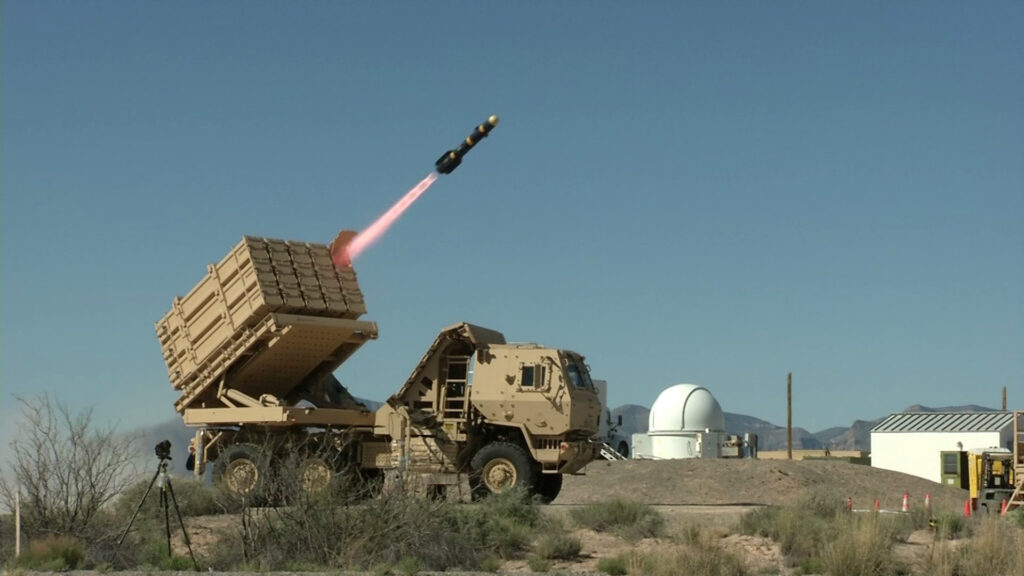
Army Multi-Mission Launcher (MML) test-fires a Longbow Hellfire.
AUSA GLOBAL FORCE SYMPOSIUM: To counter MiGs, Sukhois, Hinds, and missiles, the US Army is rushing anti-aircraft and anti-missile systems into service up to five years ahead of its original schedule. The head of the Army’s Air & Missile Defense Cross Functional Team, Brig. Gen. Randall McIntire, told me here the goal is to build on today’s uneven defenses — a lot of Patriot and a little THAAD to kill ballistic and cruise missiles, a few Stingers to down aircraft — and create multiple overlapping layers of protection.
The next five years will see a steady drumbeat of new systems:
- 2020: The first battery of MSHORAD, highly mobile, lightly armored Stryker vehicles with anti-aircraft guns and missiles to protect mobile frontline forces from enemy helicopters and drones. That’s five years ahead of the original fielding date, 2025.
- Late 2020 or early ’21: A new network link between Patriot and THAAD missile defense batteries, so Patriot can both protect THAAD from air attack and use THAAD’s longer range radar to find targets. This link was originally going to wait until the IBCS network was fielded in 2022 (below).
- 2021: The IPFC Multi-Mission Launcher (MML), a truck-mounted system bigger and less mobile than MSHORAD. MML’s larger magazine of larger missiles can reach targets at higher altitudes and longer ranges, especially cruise missiles and fixed-wing aircraft, as well as helicopters.
- 2022: The IBCS network, which will share targeting data among all air and missile defense systems, allowing any launcher to fire at targets spotted by any radar. (IBCS will incorporate the THAAD-Patriot link). This is the one system that’s been delayed, although the decision to do so predates the creation of the CFTs: IBCS was originally going to be fielded this year, but software development proved daunting.
- 2023: The first prototype platoon of 50 kilowatt lasers mounted on Stryker vehicles, which will join MSHORAD missile launchers in frontline forces to defend against small drones. That 2023 date isn’t final, McIntire told the AUSA conference here: “We’re looking at, can we move that to the left a little bit?”
The Army is also working on a larger truck-mounted laser — less mobile but more powerful — in the 100 kW range. McIntire and his fellow officers didn’t offer a fielding date for that one. The Army has previously said it will be test-fired in 2022, but don’t be surprised if it’s accelerated.

Brig. Gen. Randall McIntire
When all these weapons are fielded, the plan is to group them in composite air and missile defense battalions, one for each of the Army’s 18 active and National Guard divisions. Each battalion would have three Stryker-mounted MSHORAD batteries — two armed with missiles and one with lasers — to move with the combat brigades. The battalion would also have one truck-mounted IFPC battery — mixing Multi-Mission Launchers and 100 kW lasers — to provide long-range, high-altitude coverage from relatively static sites in the rear. At higher levels, Patriot and THAAD missile defense launchers might also be integrated with offensive missiles and artillery (aka Long Range Precision Fires) to destroy enemy missiles before they can launch.
How will the Army afford all this new equipment, especially on top of the other seven Cross Functional Teams‘ proposals, such as robotic tanks, scout helicopters, and long-range missiles? That’s a huge unanswered question. The Army has already reallocated over $1 billion in Science & Technology (S&T) funding over 2019-2023 five-year-plan, sacrificing projects that didn’t align with its Big Six modernization goals. (Air and missile defense is No. 5). But actually producing and fielding new equipment is markedly more expensive than developing the technology — and air and missile defense systems are some of the most complex, costly kit the Army has.
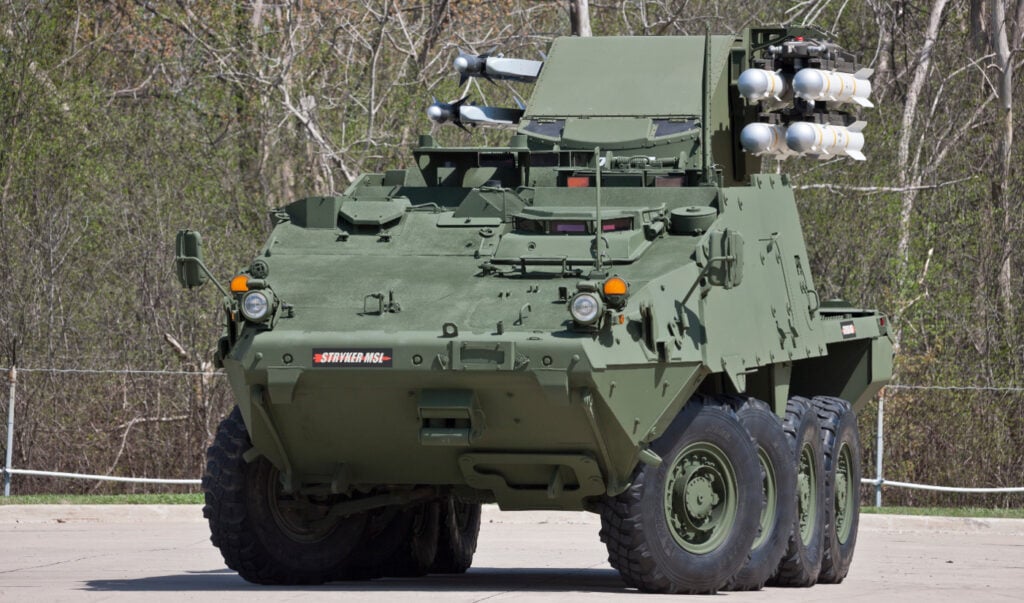
Stryker vehicle armed with anti-aircraft missiles.
Multi-Domain Battle
Last fall, when Army Chief of Staff Mark Milley introduced his Big Six modernization priorities and created the Cross Functional Teams to advance them, he ran down the list. First came long-range precision firepower to outgun Russian and Chinese missiles and rockets. Second and third came armored vehicles and aircraft to move on the ground and in the air. Fourth came the network, to communicate through enemy jamming. Those are all vital military functions, he declared, but “none of that’s going to matter if you’re dead.”
That, Gen. Milley said, is why his fifth priority is air and missile defense, to protect the force as it shoots, moves, and communicates. (The sixth is soldier lethality, better equipment and training for the infantry on foot).
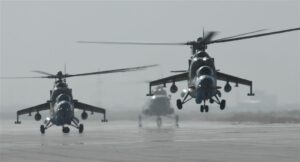
Russian-made Hind attack helicopters in Afghan service.
The context into which these weapons all fit is called Multi-Domain Battle, the Army’s concept for complex, brutal conflicts against well-armed adversaries like Russia and China. In many ways, MDB is a reaction to post-Cold War overconfidence. The Army largely disbanded its anti-aircraft units in the 1990s, trusting Air Force, Navy, and Marine Corps fighters to sweep the skies of threats and provide fire support on-call. Army missile defense flourished but focused on stopping small numbers of ballistic missiles launched by a lower-tier threat like North Korea or Iran.
Russia and China, however, have small but growing numbers of high-end fighters like the Sukhoi Su-30, dense anti-aircraft defenses, and large arsenals of non-nuclear ballistic missiles, cruise missiles, and artillery rockets. Such an Anti-Access/Area Denial (A2/AD) force could keep US aircraft at bay while bombarding US surface ships and ground forces.
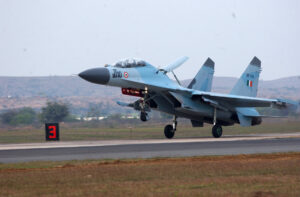
Russian-made Sukhoi Su-30 in Indian service
In such a conflict, Army forces have to defend themselves from air and missile threats. What’s more, US commanders aren’t content to sit at a relatively safe distance and trade long-range salvoes with the adversary. Instead, they plan to push forward on land, sea, air, space, and cyberspace (hence “multi-domain”) to find weak points in the A2/AD defenses, crack them open, and penetrate deep into vulnerable areas. Army forces might be the cutting edge, destroying enemy anti-aircraft radars and batteries on the ground so US airpower can break through.
As ground units move forward, they need air and missile defense that moves forward with them. That’s what MSHORAD — Maneuver Short-Range Air Defense — has been the Army’s most urgent air & missile defense priority.
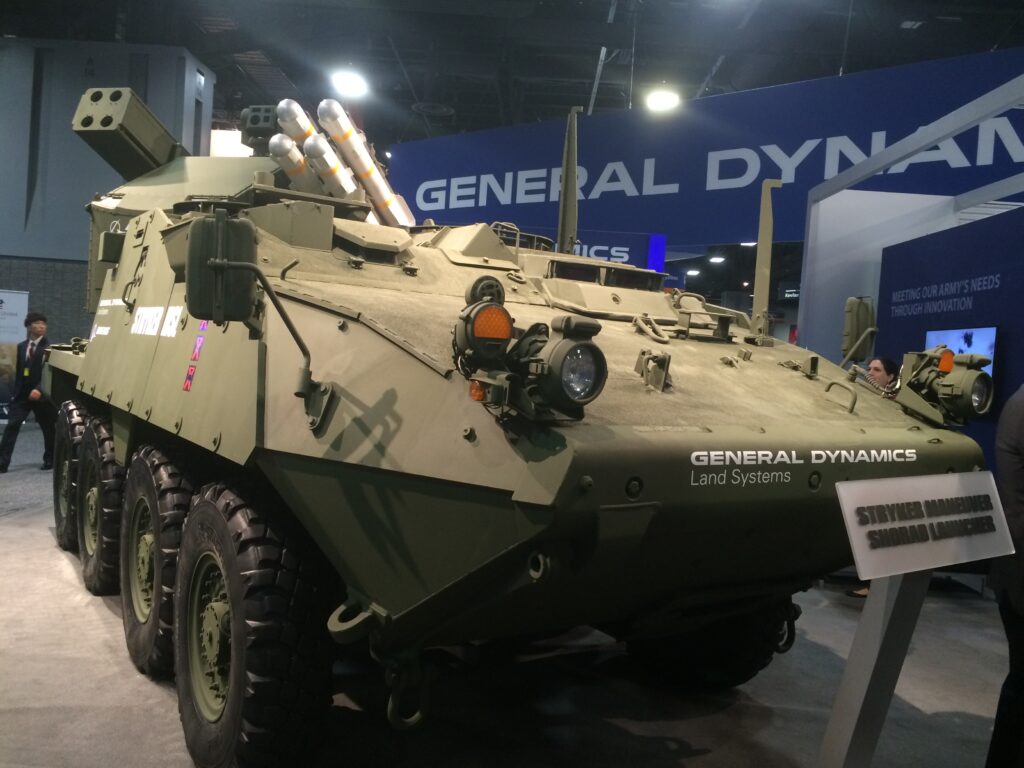
Anti-aircraft Stryker variant.
MSHORAD, IFPC, & C-RAM
The Army has already restored some of its old Stinger missile force, training 104 two-person teams with the shoulder-fired version and getting Humvee-mounted versions, called Avenger, out of storage. But for a fast and lethal Multi-Domain Battle, the service wants longer-range missiles, like AIM-9X and Hellfire, on a vehicle that was both better protected and could keep up with frontline tank units. Rather than revive the tracked M6 Linebacker (a variant of the tank-like M2 Bradley), the Army decided to install MSHORAD on the eight-wheel drive Stryker.
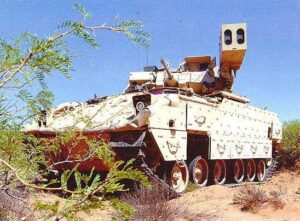
M6 Bradley Linebacker
“We had the whole wheeled/tracked debate,” McIntire told me. Wheels aren’t as mobile over soft or broken ground, hindering them in cross-country assaults, but air defense vehicles are meant to hang back a bit behind the front line, so they’re protected from ground attack while they protect the force from air attack. In that tactical context, he said, the Stryker’s eight-wheel-drive is fine. Compared to Bradley variants, the Stryker’s greater capacity — for weight, space, and electrical power — makes it much easier to install and upgrade new systems like anti-aircraft guns, missiles, or lasers.
Often such debates take years of back and forth within the Army, as lengthy memos and passive-aggressive emails volley back and forth between Training & Doctrine Command (TRADOC), Research & Development Command (RDECOM), and Program Executive Offices (PEOs). But Milley created the Cross-Functional Teams to bring together representatives from all these tribes to accelerate the process. With Milley and other top leaders backing them up, McIntire’s CFT for air and missile defense moved MSHORAD’s fielding from 2025 to 2020.
“We shaved five years off,” McIntire told me proudly. “Got the directed requirement signed in two and a half months” — a process that normally takes more than a year.
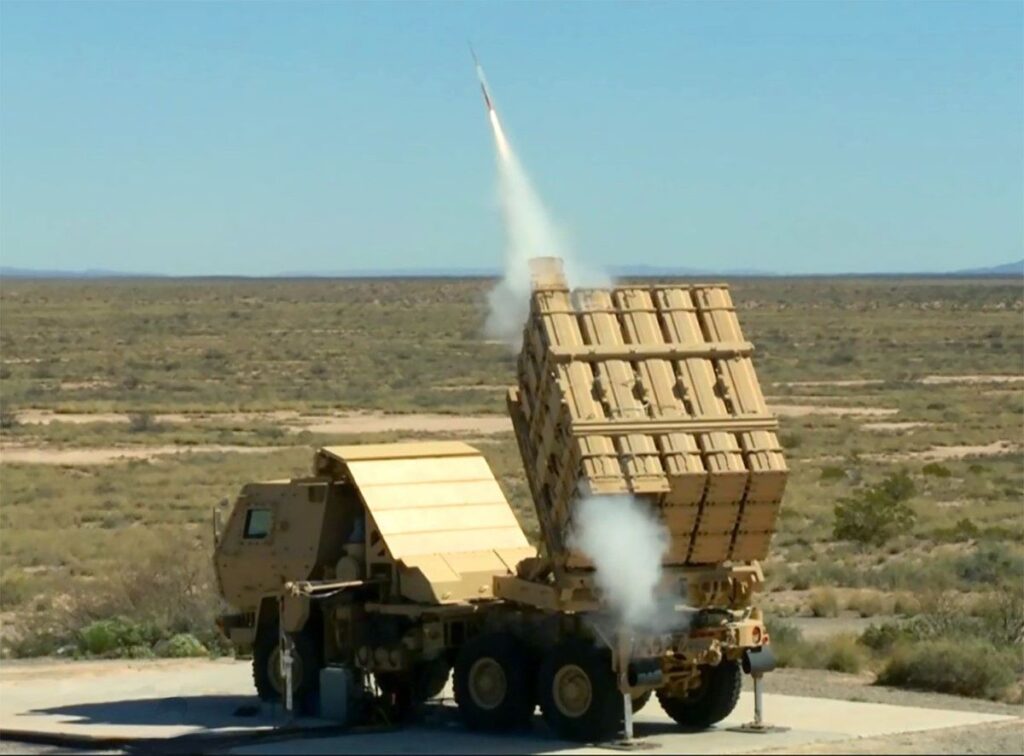
IFPC Multi-Mission Launcher (MML) firing
Backing up MSHORAD will be IFPC, the awkwardly named Indirect Fire Protection Capability. Whereas MSHORAD need off-road mobility and armor protection to follow just behind frontline units, IFPC is a second line of defense protecting static sites — such as bases — or semi-static sites that can move but don’t do so constantly — such as command posts. That’s why IFPC systems like the Multi-Mission Launcher and the 100-kilowatt laser can be mounted on trucks, which, while lacking a Stryker’s mobility and armor, can carry much larger weapons.
Instead of developing IFPC, one reporter asked here, why does the Army just buy Israel’s proven Iron Dome anti-missile system? IFPC’s primary mission is defense against cruise missiles, McIntire explained. Iron Dome deals with slower, less sophisticated targets: rockets, artillery shells, and mortars. By about 2023, IFPC will be upgraded to deal with those lower-end problems too, but for now the US military is content with a purpose-built system called C-RAM.
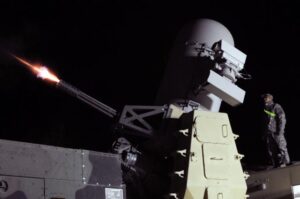
C-RAM (Counter Rocket, Artillery, & Mortar) firing during a test in Iraq.
C-RAM was an urgent improvisation during the Iraq war, a naval Phalanx gatling gun converted to protect land bases instead of ships. But it was also the forerunner of a new kind of cooperation between offensive and defensive forces, McIntire told me. When C-RAM’s radar picks up incoming rounds, it not only cues the Phalanx gun and issues a warning to troops nearby, it also calculates backward along the threats’ trajectory to locate where they were fired from. Then it can pass this data along to friendly forces that can retaliate: local ground troops, attack helicopters, or artillery.
C-RAM is a small-scale, tactical example of an idea McIntire wants to scale up dramatically. He envisions a future network of sensors that can detect enemy missile launchers so US long-range precision firepower can destroy them — preferably before they even get to fire — while US missile defenses shoot down whatever weapons the enemy does manage to launch.
Today, McIntire told me, Army field artillery and air & missile defense are like two boxers, one who can only punch and the other who can only block. “We’ve got to have one boxer that has the ability to strike and block simultaneously,” he said. “That’s the speed that we’re going to need in the future.”
Subscribe to our newsletter
Promotions, new products and sales. Directly to your inbox.
